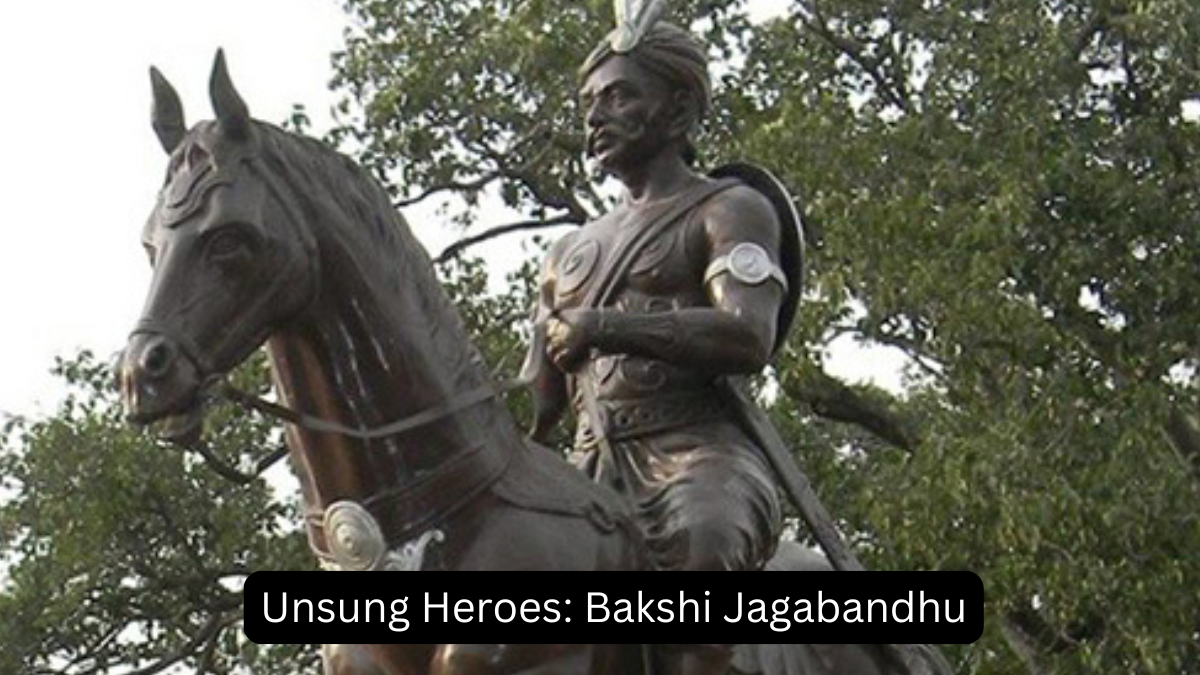India’s freedom struggle is filled with not just famous names but also unsung heroes whose stories are less known but equally inspiring. One such hero is Bakshi Jagabandhu, a brave leader from Odisha who led the Paika Rebellion of 1817 against the British East India Company. His courage, leadership, and love for his motherland made him a symbol of resistance in the early fight for independence.
Who was Bakshi Jagabandhu?
Bakshi Jagabandhu was the hero of the Paika rebellion of 1817 in Khordha. Born possibly in 1773 in Rorunga, near Puri, his actual name was Jagabandhu Vidyadhar Mahapatra Bhramarbar Ray. His ancestors were the commander in chief or Bakshi of the Khordha army. Therefore Jagabandhu was popularly known as Bakshi Jagabandhu. Killa Rorunga was purchased by his ancestors which they had retained till the time of British occupation of Odisha in 1803.
First settlement in Khordha
- Though in the first settlement in Khordha in 1804-05, Jagabandhu claimed the zemindaries of parganas Limbai, Rahanga, Serai and Chabiskud along with Rorunga as his ancestral property, the British government however ed him only Rorunga which was again ed in the next settlements in 1805-06 and 1807-08.
- As zemindar of Rorunga, Bakshi was depositing his zemindari jamma in the collector’s treasury in Cuttack. But by the advice of Krushna Chandra Sinha, a Bengali dewan he deposited the jamma with the Tehsildar of Puri as Puri was nearer to Rorunga.
- The Tehasildar who was related to Krushna Chandra Sinha fraudulently recorded the rent as Rahanga Ogharia or part of Rahanga in government records, the zemindari newly purchased by Krushna Chandra Sinha by dubious means.
- Thus though Jagabandhu paid the jamma of his estate those were misappropriated with the connivance of revenue officials for which the zemindari fell in arrears in government records.
What happened when the Zamindari was put into sale?
- In 1808-09 when the zemindari was put into sale for recovering the arrears, Krusha Chandra purchased it without the knowledge of Jagabandhu.
- But after the matter became known to Jagabandhu he prevented Krushna Chandra from taking physical possession of the pargana for which the dispute went to the Collector of Cuttack.
- The collector Mr Trower after verifying the matter was satisfied that Rorunga actually belonged to Jagabandhu and it was fraudulently annexed with Rahanga.
- He therefore issued order to separate Rorunga from Rahanga and restore its zemindari to Jagabandhu. Having lost the case in the collectorate, Krushna Chandra made a fresh representation to the government questioning the original title deed of Jagabandhu pertaining to Rorunga.
- The government therefore forbade further engagement with Jagabandhu until he was able to establish with a title deed or in course of law in Calcutta.
- But by that time he was so much dejected that he lost the mental ability to fight the case in Calcutta.
- By that time he subsisted himself and his family with the generous contributions of the people of his zemindari where he commanded lot of respect and good will.
Victim of traditional zemindars
- Jagabandhu was not the only victim of such fraudulent transaction of zemindari estate but also many other traditional zemindars who lost their zemindaries to many Bengali amlas appointed by the company.
- After a series of annual settlements from 1804, many paiks or peasant militias lost their land as many of those lands were rent free granted to them by the former rulers.
- They were financially ruined due to sudden rise of land revenue demand and scrapping of cowry currency and rise in the price of salt due to the monopoly in salt trade by the company.
- Now Jagabandhu who as former commander in chief of the state enjoyed love and respect of the paiks seized the opportunity of leading a revolt against the company government.
- The spark to the revolt was provided by a group of 400 Kandh tribe of neighboring Ghumusur state who were earlier disgruntled with the British government for interfering in their social custom and imprisoning their king Srikar Bhanja for failing to meet the demand of the British government.
- They invaded Banpur, a neighbouring town of Khordha and set fire the police station and other government buildings.
- They were joined by the paiks under the leadership of Bakshi Jagabandhu with whom they assassinated many officials loyal to the government, plundered the treasury and the commercial ship in Puri.
- After capturing Banpur, they marched to Khordha and captured it after the panic stricken British officials fled away to Cuttack.
- The spark of the revolt was thereafter felt in Kujanga and Kanika whose chiefs and paiks were also dissatisfied with the government.
- Though the uprising by the end of 1817 was ultimately crushed by the government, they failed to capture the ring leader Bakshi Jagabandhu whose abscond was possible due to the mass scale support and sympathy he enjoyed not only in Khordha but also in neighboring Baud, Ghumusur and Nayagarh states where he was given shelter and protection mostly by the tribal leaders.
Proclamation of reward to capture Bakshi
Though the British government received regular intelligence inputs about his whereabouts, he managed to escape from their combing operation. Their proclamation of reward to capture Bakshi either living or dead also did not yield any result. Thus having failed to capture him, the government resorted to pressure tactics by arresting his two wives, minor sons and personal attendants and kept them confined in Barabati fort. But this also did not yield any result as Bakshi was not bogged down by this blackmailing. The government therefore released them.
Surrender to government
Thus having failed in all fronts the government now decided reconciliation with him. Through the king of Nayagarh he was assured protection and no action in case he surrendered and would be given a monthly pension of Rs 150 but would have to reside in Cuttack with his family. Since this was an honourable settlement proposed by the government, the king of Nayagarh prevailed upon Jagabandhu to accept the terms and surrender to government. This led Bakshi to surrender to government in 1825 and he stayed in Cuttack till his death in 1829.




 Weekly One Liners 05th to 11th of Januar...
Weekly One Liners 05th to 11th of Januar...
 MeitY Launches PARAM SHAKTI Supercomputi...
MeitY Launches PARAM SHAKTI Supercomputi...
 Akasa Air Enters IATA, Becomes India’s F...
Akasa Air Enters IATA, Becomes India’s F...







